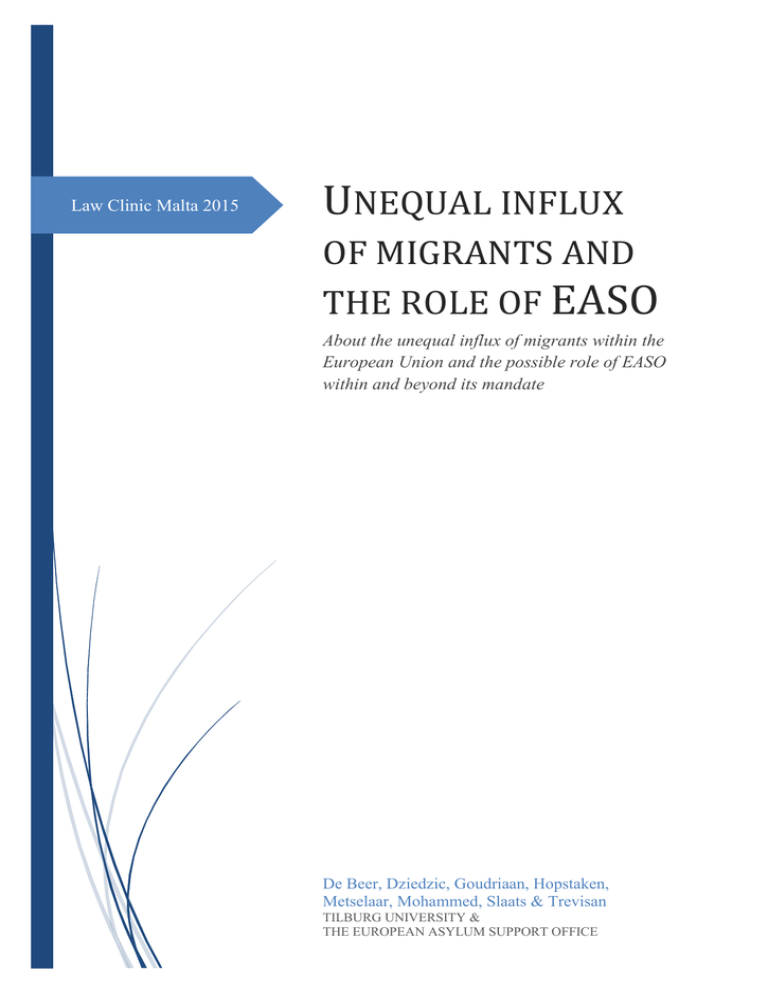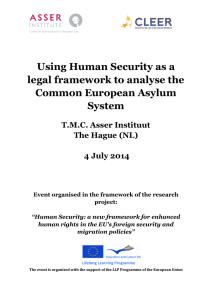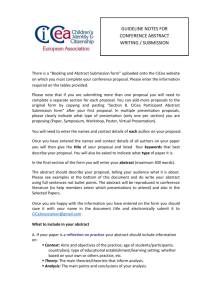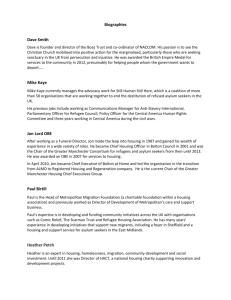U EASO NEQUAL INFLUX OF MIGRANTS AND
advertisement

Law Clinic Malta 2015 UNEQUAL INFLUX OF MIGRANTS AND THE ROLE OF EASO About the unequal influx of migrants within the European Union and the possible role of EASO within and beyond its mandate De Beer, Dziedzic, Goudriaan, Hopstaken, Metselaar, Mohammed, Slaats & Trevisan TILBURG UNIVERSITY & THE EUROPEAN ASYLUM SUPPORT OFFICE 1 1. INTRODUCTION Due to a growing number of conflicts in the world and the economic prosperity on the European continent, more and more people try to reach the European soil. Among them are people in right of international protection, such as refugee protection or subsidiary protection. Refugee protection is based on Article 1A (2) of the Convention Relating to the Status of Refugees, the so-called Geneva Convention. Subsidiary protection is based on international human rights treaties, predominantly in Europe, the European Convention on Human Rights (ECHR). The Geneva Convention states that a refugee is someone who is in: “…well-founded fear of being persecuted for reasons of race, religion, nationality, membership of a particular social group or political opinion, is outside the country of his nationality and is unable or, owing to such fear, is unwilling to avail himself of the protection of that country; or who, not having a nationality and being outside the country of his former habitual residence as a result of such events, is unable or, owing to such fear, is unwilling to return to it.”1 States are prohibited to return or expel a refugee to a place where his life or freedom is in danger on account of his race, religion, nationality, membership of a particular social group or political opinion (principle of non-refoulement).2 The European Court of Human Rights has in a comprehensive body of case law interpreted article 2 and 3 of the ECHR to include the principle of non-refoulement.3 States are thus prohibited to send persons back to a particular territory when they are refugees or when their right to life or their right not to be subjected to torture, inhuman or degrading treatment would be violated in that territory. Article 78(1) of the Treaty of the Functioning of the European Union reiterates that all Member States must respect the Geneva Convention and other relevant treaties, which brings us to the problem that is at hand here. 1.1 PROBLEM For geographical reasons, most migrants enter Europe through Spain, Italy, Greece or Malta. In the view of EU and government officials, the Dublin Regulation is the cornerstone of the Common European Asylum System (CEAS). Without it, asylum seekers could lodge applications open in several Member States and it wouldn't be clear which state would be responsible for making a decision. The aim of the Regulation is to the ensure that one Member State is responsible for the examination of an asylum application, to deter multiple asylum claims and to determine as quickly as possible the responsible Member State to ensure effective access to an asylum procedure. The Dublin Regulation establishes a hierarchy of criteria for identifying the Member State responsible for the examination of an asylum claim in Europe. This is 1 Refugee Convention, article 1(2) Refugee Convention, article 33(1) 3 See for example inter alia Soering v. United Kingdom (1989) 11 EHRR 439; Üner v. The Netherlands App no 46410/99 (ECtHR 18 October 2006); Na v. United Kingdom App No 25904/07 (ECtHR)17 July 2008); Saadi v. Italy App no 37201/06 (ECtHR 28 February 2008); Chahal v United Kingdom (1996) 23 EHRR 413; Salah Sheekh v. The Netherlands App no 1948/04 (ECtHR 11 January 2007); N v. United Kingdom App no 26565/05 (ECtHR 27 May 2008); Vilvarajah v. United Kingdom (1991) 14 EHRR 248; D v. United Kingdom (1997) 24 EHRR 423 2 1 2 predominantly on the basis of family links followed by responsibility assigned on the basis of the State through which the asylum seeker first entered, or the State responsible for their entry into the territory. The Dublin Regulation among others determines that the Member State in which the asylum seeker first enters, is the State responsible for the asylum procedure.4 For example: an asylum seeker who came to the EU via Hungary and then traveled to Belgium, would likely be sent back to Hungary to have their application examined. This, however causes an imbalance in responsibilities between Member States since the influx is not equally spread across Europe. In fact, the migrant influxes at present heading to Europe stress mainly the border control of its south and east Member States, posing a serious challenge to the principle of solidarity within the European legal framework. At current, the ever growing numbers of migrants make it hard for the above mentioned States to adequately protect those people in need. This is especially the case since the ongoing financial crisis deteriorated the economic position of these countries (think for example of the situation in Greece). In this sense, the migrants influxes are not only stressing Member States differently, but also those legally responsible appear to be not able to face the present humanitarian crisis. Not only is there a disproportionate influx of migrants, moreover, certain Member States cannot deal with this uneven influx. 1.2 ASSIGNMENT The European Asylum Support Office (EASO) urged the need for a study on shared reception facilities as a possible solution for the problem of unequal influx of asylum seekers. Based on the European principle of solidarity, which forms the basis of the European Union, sharing care services and shelter would appear to be a logical and feasible solution to help the Member States dealing with the greatest numbers of influx of asylum seekers. However, there are a number of practical issues at stake. First of all, should the asylum seekers be distributed among the other Member States? And if so, should this be based on their number of inhabitants, the gross domestic product or on the square kilometers of the Member State? Second, to what extent the wishes of the asylum seekers themselves need to be taken into account? Should they be placed close to their families and friends? Does language play a role in the distribution process? Third, does the reception facility only count as shelter or should the receiving State take over the entire asylum procedure? This paper answers these questions and examines possible ways of sharing facilities. In doing so, the paper will outline the experiences of sharing penitentiary detention centers in the Netherlands as an example how European Member States can make use of each other’s facilities in case of distribution problems. The first part of this paper will present two ‘first-order’ approaches. It will firstly elaborate on the possibilities of shared facilities and will then look at possible improvements in State harmonization related to the EASO mandate. The second part of the paper will approach the initial assessment from a more theoretical perspective and gives an assessment on fair sharing within the European Union. 4 Regulation (EU) 604/2013 of 26 June 2013 establishing the criteria and mechanisms for determining the Member State responsible for examining an application for international protection lodged in one of the Member States by a third-country national or a stateless person (Recast) (Dublin regulation), article 3(1) jo. 7(1) jo. 13(1). 3 2. SHARING FACILITIES As mentioned in the introduction, the EASO urged for a study on shares facilities because this might offer a solution for the unequal increasing number of influx of asylum seekers in Europe. In this paragraph we will looked at the European Relocation Malta (EUREMA) pilot programme and the example of sharing of detention facilities in the Netherlands. These two initiatives might be also useful in the problems that occur due the unequal influx of refugees in Europe. 2.1 EUREMA First of all, the EUREMA programme will be discussed. EUREMA is a pilot programme with regards to relocation to assist Malta to cope with the pressures of hosting a relatively large number of recognized beneficiaries of international protection (EASO, 2012:1). EUREMA was launched as a cooperation between the Maltese Ministry of Home Affairs, International Organization for Migration (IOM) and the United Nations High Commissioner for Refugees (UNHCR). EUREMA aimed at ensuring that asylum seekers entering the EU via Malta would be relocated to participating States. Each participating State pledged to take in a certain number of persons in their country. EUREMA provided the organizational framework for preparing and implementing the relocation. Participating states could opt to relocate via the EUREMA pilot project or could choose for a bilateral arrangement with Malta (EASO, 2012:1). The majority of the countries chose for a bilateral arrangement with Malta, reasoning that a bilateral arrangement was the fastest and most efficient way to provide solidarity in an emergency situation.5 This method was also chosen because it shares the most similarities with the resettlement exercises (EASO, 2012). Other States opted for the EUREMA pilot.6 Citing reasons for this were: willingness to support and participate in the pilot project, the possibility to use the European Refugee Fund (ERF) and gaining experience with relocation (EASO, 2012:8). In the first phase of EUREMA in 2011, ten Member States pledged 253 places, and in total 227 people were relocated. In the second phase of EUREMA in 2012, a number of 15 States pledged 356 places, but the exact number of persons relocated is unsure as the process is currently still ongoing (EASO, 2012). After the programme ended, it has been reviewed by the EASO. EASO states that the possibility of benefiting from the available expertise of UNHCR and IOM within the EUREMA pilot project encouraged Member States to participate in this exercise. The EUREMA project was broadly seen as a tool to facilitate the relocation process and share experience and best practice between project partners. The majority of EU Member States and Associated Countries stated that their decision to participate in relocation activities was a political decision of solidarity towards Malta, in line with the EU spirit of solidarity and burden sharing enshrined in the Stockholm programme and the European Pact for Immigration and Asylum EASO, 2012:8). 5 Eight EU Member States and Associated Countries (DE, DK, ES, IE, NL, NO, CH, LI) have chosen bilateral arrangements (EASO, 2012:8). 6 Twelve Member States preferred to relocate via the EUREMA pilot project (BG, DE, FR, HU, LU, LT, PL, PT, RO, SK, SI, UK) (EASO, 2012:8). 3 4 However, there are also some concerns in relation to the pilot program. The first thing that can be learned from EUREMA is that Member States fear that relocation would be a pull-factor for irregular migration. Therefore Member States were not always willing to accept high numbers of persons in their home States. Other concerns Member States indicate are related to the influence that relocation could have on the resettlement quotas in the European Union, and concerned questions about the financial, legal and political implications relocation could possibly have. What thus can be learned from EUREMA is that Member States were not always supportive the idea of relocation, but that nevertheless some efforts have already been made to relocate persons within the European Union. 2.2 SHARED DETENTION FACILITIES Sharing facilities has occurred in other areas than migration law. Think for example of the sharing of penitentiary institutions (PI’s) in criminal law. The most recent example concerns the lease of Dutch PI’s to Belgium and Norway. Under- and overcrowding of prisons in Europe is a much discussed phenomenon nowadays. Countries such as Belgium and Norway cope with this overpopulation problem while the Netherlands is faced with the opposite. 7 In 2014, Belgium had 11.769 prisoners as a result of the overcrowding problem (Statistics Belgium, 2015). In Norway, there is a waiting list for the execution of prison sentences and besides this problem, they need to cope with a further shortage of detention capacity as a result of the renovation of antiquated penitentiaries. The result is that detention capacity is (temporarily) unavailable. In 2009 the Netherland and Belgium have entered into a unique agreement, known as the Penitentiary Treaty8, which made it possible for the Netherlands to lease its PI in Tilburg to Belgium. The Netherlands made the prison and the prison staff available for the placement of at least 500 Belgian detainees for a period of three years. The same practice will become reality between Norway and the Netherlands, as at this moment the treaty between both countries will be finalized. What was shown in this situation of sharing detention facilities is that prisoners from Belgium could be transferred to the Netherlands by means of a legally binding agreement. The described experience is clearly of significant importance: two countries agreed that criminal sentences which are imposed in one country are exported to other countries. This means that the Netherlands made prison cells and personnel available for the enforcement of the Belgium custodial sentences but that Belgian law and regulations could be applied within the PI. The PI in Tilburg was designated as a branch of the Belgian PI in Wortel. The Treaty states that a Belgium governor will be appointed in Tilburg, and the site will be governed by Belgium regulations. 9 The remainder of the staff will remain Dutch. The Belgium prisoners will serve a part of their sentences in the Netherlands and return to Belgium to start their rehabilitation process. This means that no leave or release takes place in the Netherlands. They will therefore not be released from prison on Dutch 7 Kamerstukken II 2008/09, 24 548, no. 310; Kamerstukken II 2008/09, 24 548, no. 256 & Kamerstukken II 2008/09, 24 548, no. 270. 8 Agreement between the Kingdom of the Netherlands and the Kingdom of Belgium on the use of a prison in the Netherlands for the purpose of the execution of Belgian sentences of imprisonment (Trb. 2009, 202). 9 Article 1 of the Convention 5 territory. The Treaty itself is fully based on Dutch law. The PI in Tilburg remains Dutch territory in which the Dutch criminal laws apply. Only the Dutch public prosecutor is authorized to make inquiry into criminal offenses within the institution. In case of an escape, a prisoner can be held by the Dutch authorities pending a European arrest warrant. The Treaty further stipulates that detainees are transported to Belgium in case of hospital visits. The medical care for detainees within the PI will be based on Dutch law.10 The leasing experiment was evaluated and was considered to be very positive. In this case there was a situation of an overcapacity in Belgium and an under capacity in the Netherlands which led to the sharing of facilities. In so, the factual necessities which caused the sign of the Treaty resemble the one related with the emergency of the migration influxes. This experiment showed that it is possible for two Member States to sign a bilateral agreement on sharing a facility. An advantage for the Netherlands was that the lease to Belgium could prevent early closing of other penitentiary institutions and it created a lot of jobs that otherwise would vanish. However some (practical) problems arose. An example hereof is about which kind of food (Dutch of Belgian) should be served and which culture (Dutch or Belgian) should prevail in daily affairs. Therefore, some lessons could be learned from this experiment. The first lesson that could be learned from the experience of sharing detention facilities is that the interaction between the prisoners (or migrants) and staff needs to be tuned. The second lesson that can be learned is related to the essential differences in legal systems, it became clear that these should be in line with each other. Another major point that should be kept in mind is the distance of prisoners (or migrants) to their loved ones. A fourth important insight was that the quality and positive experiences of approach and communication quickly deteriorate if prisoners and staff did not speak each other’s language. 2.3 OTHER INITIATIVES Besides EUREMA and the Dutch sharing of detention facilities, the European Network of Asylum Reception Organizations (ENARO) and the European Agency for the Reception of Asylum Seekers (EPRA) are organizations that have shown how European organizations and Member States together can arrange the reception of asylum seekers. 2.4 RECOMMENDATIONS TO EASO BASED ON THESE INITIATIVES Some best practices and recommendations to EASO can be derived from the above mentioned initiatives. Based on the mandate of EASO, it could play an important role with regards to sharing reception facilities between Member States. EASO can for example collect best practices from Member States that have experience with the sharing of facilities, such as the Netherlands, Belgium and Norway, but also with regards to relocation in the context of EUREMA. Furthermore, EASO can use its expertise in collecting and sharing data to collect information on available reception capacity and facilities that Member States possess, so that other Member States can see which Member States have extra capacity they could potentially use. In addition to this, EASO could cooperate with the European Migration Network (EMN) in 10 Article 4 of the Convention 5 6 order to receive more information about the current reception capacity so that Member States can use this capacity and EASO can again share this information. Second, EASO can further the provision of trainings personnel regarding the sharing of reception capacity, and as we know, EASO is already develop a training in this area, which is strongly encouraged. Furthermore, what EASO could also do is cooperate with other organizations such as Frontex, UNHCR, ENARO and EPRA to explore possibilities of sharing reception facilities and in this way EASO can benefit from the expertise of these organizations and continue supporting the UNHCR in their efforts of continuing intra-EU relocation. With these strategies EASO can build up trust between the Member States that it is possible to relocate asylum seekers and to share the reception capacity that they have in order to help each other. EASO could support small-scale pilot programs in this regard too, and thereby show results to Member States as part of this bottom-up approach. In supporting the existing efforts and adding to the sharing of information, EASO would not directly improve solidarity between the Member States, but it would show how recent initiatives already had positive effects and are a solution to the unequal distribution problem. 3. FIRST ORDER APPROACH : IMPROVING IMPLEMENTATION AND STATE PRACTICE Important objectives of EASO are to achieve similar outcomes of similar asylum applications, equal treatment of persons and adherence to the principles of EU and International (Human Rights) law in the application and implementation of the CEAS. The strategic guidelines for the further development of the Justice and Home Affairs (JHA) area adopted by the European Council called for a stronger role for the EASO in promoting a coherent, comprehensive and consistent implementation of the recast EU asylum package to ensure that a genuine CEAS is achieved (EASO, 2014:5). By providing support, facilitating, coordinating and strengthening practical cooperation between EU Member States, the EASO as an independent center of expertise on asylum, aims to contribute to the implementation and development of the CEAS (EASO, 2014:6). In this framework of expertise on asylum, the EASO also has a role in informing the European Commission on the developments in the CEAS and in providing scientific input for EU policy and legislation which have an impact on asylum and migration (EASO, 2014:6). In light of its mandate and in the effort of EASO to meet these tasks the need for a bottom-up approach in order to address undesired variations in the implementation of the CEAS in the different European Member States and the lack of solidarity between Member States in the CEAS is identified. For such a bottom-up approach to succeed evidence based policy input on national asylum practices needs to be gathered by actively involving Member States and its asylum officers. This will enable the creation of the requisite added value for Member States of proposed changes and their willingness to implement them. In addition to conducting desk research, consulting existing research conducted by other EU agencies and institutions and evaluating the outcomes of various pilots and initiatives, such evidence based policy input on national asylum practices can be gathered in a multi-purpose online environment (‘CEAS wiki’). The CEAS wiki can inter alia be used to: reinforce existing initiatives of EASO; identify problems in the application of the CEAS; 7 support asylum officers by offering easy-access and up to date information; promote mutual understanding and stimulate practical cooperation between Member States; maintain a dialogue with civil society and academia and provide up to date information: inform the public. The CEAS wiki will be an overarching online environment where asylum officers and other stakeholders can be consulted and supported by communicating the results of existing and new initiatives. Connecting the existing and new initiatives in a digitalized environment will stimulate cooperation, promote mutual understanding, increase efficient information sharing and enable the inclusion of a broader audience. 3.1 REINFORCING AND CONNECTING EXISTING MECHANISMS The Country of Origin (COI) portal, the Information and Documentation System (IDS), the EASO consultative forum, and the Early Warning and Preparedness System (EPS) can all be included in the CEAS wiki to maximize the effectiveness of these initiatives and prevent fragmentation of information. The CEAS wiki inter alia should consists out of two fora. The current COI portal can be part of the restricted forum and should be exclusively accessible for national asylum administrators. It is also strongly recommended to provide access to courts and tribunals as well. This forum can function as both a helpdesk and a means for national asylum officers to maintain a permanent dialogue with EASO and with each other. By using questionnaires on a regular basis, EASO can retrieve real-time information on contemporary issues relating to the CEAS. The forum can be a means to fulfil the various objectives mentioned in the EASO work programme. The restricted forum fulfils the objective of the IDS by providing a single point of information on the organization of the EU Member States asylum, reception systems and its practical functioning (EASO, 2014:24). EU Member States representatives can provide data on changes in national policy, procedure and case law related to the asylum acquis in this restricted forum. Furthermore, the restricted forum can foster the exchange of information and best practices on reception systems and on integration measures (EASO, 2014:23). The synergy between asylum and migration can be fostered by exchanging information and best practices relevant to the return of failed asylum seekers (EASO, 2014:22). In addition to the restricted forum which includes the COI portal and the IDS, a second open forum within the CEAS wiki forum can provide for an additional online area where civil society is included in the dialogue. Governmental organizations, NGO’s, and academia can be invited to consult this forum and express their views. The results of the EPS can be published in this forum on a regular basis and the forum can provide for a platform to maintain and intensify the dialogue between EASO and the civil society instigated by the EASO consultative forum. In the light of transparency and maximizing cross-fertilization it is recommended to allow the open forum as much information from the restricted forum as reasonably possible. By monitoring both the restricted and open fora the EASO can more effectively identify practical problems in the implementation of the CEAS and can therefore better support asylum officers. Moreover, the permanent dialogue between Member States themselves, as well as between civil society, EASO and Member States will promote mutual understanding and real solidarity between Member States. Transparently linking the results of the European Asylum implementation in an online platform would 7 8 allow citizens from different Member States to review and compare common policies in so creating the requisite public support towards CEAS solidarity principle. European Commission CEAS WIKI Overarching online platform maintained by EASO Restricted forum • Access: asylum officers • Information: COI / IDS / Joint processing pilots (including results of practical cooperation meetings and twinning projects) • Communication : forum posting • EASO: helpdesk (online chat + telephone) / questionnaires / evaluations / monitoring Open forum • Access: asylum officers & civil society • Information: EPS / EASO consultation forum • Communication : forum posting • EASO: questionnaires / evaluations / monitoring 3.2 NEW INITIATIVE: TWINNING IN JOINT PROCESSING Another important recommendation is to include the concept of ‘twinning’ in existing or new joint processing pilots. Although the concept of twinning is not new within the EU, using it in the framework of the joint processing pilots seems to be (see for example European Commission, 2015). The idea is to gather Member States willing to partake in the project and add them in a pool of participants. A Member State which is situated on the outskirts of Europe will be paired with a Member States which is situated in a more central place in Europe. Germany could for example be paired with Greece to work together in the process of processing asylum requests in both Germany and Greece. Such an interaction will enable asylum officers to support each other and learn from practices in the other Member State. The close cooperation could arguably stimulate the harmonization of practices in both countries and promote mutual understanding. After a year the project would be evaluated and the participants will then be paired with a new Member State to continue the process. This rotating system promotes further harmonization between the various asylum systems and practices in the European Union. Connecting information of the various mechanisms and initiatives is a central feature of the CEAS wiki, so including the joint processing pilots and the results of its practical cooperation meetings in the restricted forum of the CEAS wiki is recommended. 9 4. SECOND-ORDER APPROACH : EXTENDING THE EASO MANDATE The apparent unequal distribution of the asylum burdens among the Member States within the CEAS system have led to a renewed increasing salience of the principles of solidarity and fair sharing of responsibilities. In the course of time several potential solutions to the underlying problem, have been suggested, and EASO can be seen as a key actor in this regard (McDonough & Tsourdi, 2012). The potential involvement of EASO that is necessary to guarantee their success would, however, outstretch EASO’s current mandate, and that is why they are being referred to in this subchapter as ‘the second order approach’. In fact, in contrast to the approaches presented in the previous subchapters, their complete implementation is being dependent on prior legislative changes in EASO’s mandate. One area necessitating such a second order approach is for example the extension of joint processing. Currently EASO is coordinating cross-country expert visits as a first step to European joint processing of asylum seekers. While this approach is still small in scale it has the potential to be broadened up in the future. For instance, the deployment of Asylum Support Teams (ASTs), as already tested in Greece, can contribute to creating more acceptance, familiarity, and a certain momentum for joint processing of asylum claims within the CEAS (McDonough & Tsourdi, 2012; Guild et al., 2015). However, for it to contribute really, on a larger scale, to the underlying problem European joint processing through teams deployed under the direct mandate of EASO would be necessary, something that at the moment definitely lies wide beyond EASO’s mandate. Another area is the relocation and resettlement of already processed refugees. In accordance with Articles 5 and 7 of its founding Regulation, EASO can play an important role in the processes of resettlement and relocation of refugees. Relocation and resettlement are very topical issues at the moment. In its new European Agenda on Migration, presented on 13 May 2015, the Commission suggested the resettlement of refugees processed by the UNHCR outside of the EU’s territory and the relocation of asylum seekers in case of an emergency situation in certain Member States caused by a sudden inflow of protection seekers, as envisioned by Article 78 (3) TFEU (European Commission, 2015a). EASO should in this regard try to raise political awareness to the need of an extension of its mandate in this area, as it already has some expertise in this area due to prior efforts such as EUREMA. Its current mandate in regard to relocation, as Article 5 of its founding Regulation clearly shows, limits EASO to be a coordinating body of voluntary relocation efforts by Member States. However, Article 5 falls under the general revision clause of the EASO Regulation and so there can be some hope that a recast could provide this mechanism some more teeth (Comte, 2010). At the moment there is a momentum in regards to the topics of joint processing, resettlement and relocation, due to amongst others, the EU’s new European Agenda on Migration. In addition to that the currently pending external evaluation of EASO’s activities, in accordance to Article 46 of its founding Regulation, can potentially add even more momentum to the issue of potentially necessary mandate changes in regard to EASO’s involvement in the aforementioned approaches. 9 10 How EASO can even further contribute to keeping this momentum is through raising the issues of solidarity and fair sharing in the aforementioned areas more often in the course of interactions with the Member States, through its consultative forum. In addition to that EASO can more explicitly communicate the difficulties faced due to its narrow mandate in regard to relocation or resettlement to relevant stakeholders such as the European Resettlement Network (ERN), or the independent assessor conducting the external evaluation, in order to create a sense of urgency in regard to mandate changes in this area. In addition to that EASO could also try to be more active in doing research on an issue that is partly responsible for the slow pace in the process of Europeanization of joint processing, resettlement and relocation policies, namely the lack of agreement on a fixed quota determining how to fairly distribute refugees across the territory of the European Union. EASO, with its knowhow on national asylum systems could definitely, alone or with the help of contracted academics, add something to the scarce research in this area and therewith further contribute solutions fostering the momentum for joint processing, resettlement and relocation. 5. CONCLUSION After reading the aforementioned we can conclude the following three issues. First of all, it is possible to tackle the problem of unequal influx of migrants by sharing of facilities between Member States. Both EUREMA and the sharing of detention centers were evaluated positively. In both cases the cooperation between states was regulated by bilateral agreements and treaties. EASO can play an important role in providing information about these initiatives and the actual reception capacity within the different Member States. Secondly, it can be concluded that it is possible, within the EASO mandate, to enhance cooperation between Member States and include civil society in the process. Concrete ideas hereof are the CEAS-WIKI and twinning of states in the joint processing of asylum seekers. These kinds of initiatives can easily be implemented and will result in closer ties between the Member States and raise public support. Thirdly, EASO should lobby and raise awareness for the extension of its mandate. This should be done so that the EASO can contribute more to tackling the problem regarding the unequal influx of migrants in different Member States of the European Union. 11 LITERATURE Comte, F. (2010). A New Agency Is Born in the European Union: The European Asylum Support Office. European Journal of Migration and Law. No 373, 397. EASO (2012). Fact finding on intra-EU relocation activities from Malta. EASO (2014). EASO work programme. European Commission (2015). Twinning. Retrieved http://ec.europa.eu/enlargement/tenders/twinning/index_en.htm. Dated: 3 July 2015. European Commission (2015a). Communication from the Commission to the European Parliament, the Council, The European Economic and Social Committee and the Committee of the Regions – A European Agenda on Migration’ COM (2015) 240 final, Brussels, 13 May 2015. Guild, E. (2015). New Approaches, Alternative Avenues and Means of Access to Asylum Procedures for Persons Seeking International Protection. CEPS Paper in Liberty and Security in Europe. No. 77-76. McDonough, P. & Tsourdi, E. (2012). Putting Solidarity to the Test: Assessing Europe's Response to the Asylum Crisis in Greece. UNHCR Policy Development and Evaluation Service. Statistics Belgium (2015). Gevangenisbevolking. Retrieved at: http://statbel.fgov.be/nl/statistieken/cijfers/bevolking/andere/gevangenen/. Dated: 28 March 2015. at: LEGAL DOCUMENTS Agreement between the Kingdom of the Netherlands and the Kingdom of Belgium on the use of a prison in the Netherlands for the purpose of the execution of Belgian sentences of imprisonment (Trb. 2009, 202). Convention Relating to the Status of Refugees (1951). (Geneva Convention). Council Regulation (EC) No 439/2010 of 19 May 2010 establishing a European Asylum Support Office. (Founding Regulation EASO) Council Regulation (EC) No 343/2003 of 18 February 2003 establishing the criteria and mechanisms for determining the Member State responsible for examining an asylum application lodged in one of the Member States by a third-country national. (Dublin II Regualtion) Treaty of the Functioning of the European Union (2007) 11





